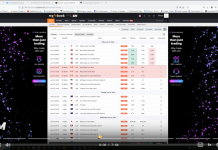 The USD crumbled across the board yesterday. Our interpretation of the market response to the Fed hike and communication is that investors believe that while the central bank is in the process of policy normalization, the pace of tightening is unlikely to derail US growth hence, the focus has now shifted to the solid global growth dynamics.
The USD crumbled across the board yesterday. Our interpretation of the market response to the Fed hike and communication is that investors believe that while the central bank is in the process of policy normalization, the pace of tightening is unlikely to derail US growth hence, the focus has now shifted to the solid global growth dynamics.
The latter signals further support to pro-cyclical FX, as well as currencies where monetary policy had been priced-in to stay ultra-accommodative for too long. More specifically:
In the near-term, one cannot rule out some pairing back of the USD’s severe losses yesterday. But, from a trend perspective, the greenback should continue to face widespread depreciating pressure on the back of compressed US real yields, the unwinding of long-positions and a still-sizeable overvaluation.
The euro now finds itself in a sweet spot: USD downside is acting as a tailwind, while solid euro-area growth prospects have only just now started to be appreciated (and priced) by the market. Furthermore, the Dutch election outcome materially reduces concern about the rise of populism in the eurozone and in that respect, it takes away some of the political risk premium that was (partially) offsetting the gravitational pull of undervaluation. The French elections remain a risk, but overall the backdrop is much more favorable for the common currency.
Try out free trial of FxWatcher service and check out the rest of today’s big banks commentaries!
Commodity FX stands to benefit more; as we have reiterated on a number of occasions, we expect AUD outperformance to continue. The Australian employment report (February) published overnight might have underwhelmed expectations (showing a 6.4k drop in aggregate employment), but this was exclusively driven by losses in part-time jobs. In contrast, full-time employment registered yet another robust gain of 27.1k, confirming the upward trend of the last several months. The increase in the unemployment rate is something worth monitoring, but we would look through it currently because it is a lagging indicator and the improvement in global demand prospects should allow for future declines.
On the other hand, the NZD may be facing a number of headwinds: GDP growth for 4Q16 came significantly below expectations (at 0.4% qoq) at a time when the market is still pricing in some material monetary policy tightening over the next two years. Further upside in AUD-NZD remains our central scenario.
Looking into today’s events, the Norges Bank, the SNB and the BoE are all expected to remain on hold, but the Norges Bank is probably the most interesting of the three. On the back of better activity data and a more upbeat regional network report, the bank should increase both its GDP and CPI forecasts for 2017 while probably also dropping any easing bias.
The NOK was severely penalized in the past week on the back of the oil price fall (we were stopped out on our NOK long spot position vs. the USD), but we think that the less-
dovish shift can offer the currency some renewed momentum.
 On the other hand, the SNB is expected to send the usual warning against its still overvalued currency without triggering significant implications for EUR-CHF, which is likely to take its cues from euro upside. Lastly, the BoE erring on the side of caution could halt sterling’s gains against the dollar, but we expect it to reinforce appetite for EUR-GBP upside and GBP-AUD downside.
On the other hand, the SNB is expected to send the usual warning against its still overvalued currency without triggering significant implications for EUR-CHF, which is likely to take its cues from euro upside. Lastly, the BoE erring on the side of caution could halt sterling’s gains against the dollar, but we expect it to reinforce appetite for EUR-GBP upside and GBP-AUD downside.
















